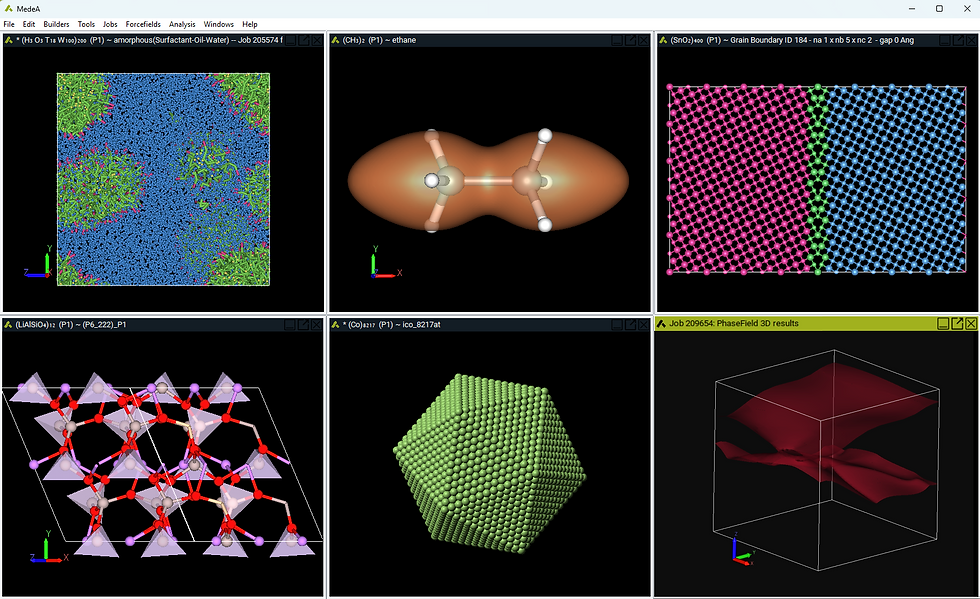Materials Design attended Petrophase (The International Conference on Petroleum Phase Behavior and F
- Katherine Hollingsworth
- Jul 16, 2018
- 3 min read

Materials Design, Inc. attended Petrophase (The International Conference on Petroleum Phase Behavior and Fouling) July 8th – 12th, 2018, Park City, Utah.
The International Conference on Petroleum Phase Behavior and Fouling (PetroPhase) was started in 1999 and is the premiere international meeting where industrial and academic researchers meet to discuss the latest findings in
Petroleum properties and chemistry
Upstream, midstream and downstream fouling
Processing and refining petroleum
Asphaltene and wax deposition
Emulsions
Multiphase flow
Application of the latest scientific techniques to petroleum systems
And all other aspects related to flow assurance
“It was exciting to witness how atomistic simulations continue to provide value in petroleum research," said Dr. Marianna Yiannourakou, a senior research scientist and developer at Materials Design.
"This was demonstrated in many talks including one of the keynote addresses in which the use of molecular dynamics simulation elucidated complex phase behaviour of petroleum crudes on the nanoscale. This skilfully organized conference had outstanding quality of talks addressing state-of-the art experimental techniques and thought provoking modelling insights. It has energized and inspired us to continue to enhance the capabilities of MedeA for chemical, petrochemical, drilling, and mining applications. The MD team enjoyed having stimulating discussions and exchanging ideas with the participants. We deeply appreciate all the valuable feedback we received. We’d be delighted to continue these conversations and are looking forward to the next PetroPhase meeting in Kanazawa, Japan in 2019.”
Materials Design scientists, Marianna Yiannourakou, Alexander Mavromaras, Xavier Rozanska, and Phillipe Ungerer, in collaboration with V. Lachet, J.M. Teuler, B. Rousseau, J. Collell of IFP Energies Nouvelles, LCP - Univ. Paris Sud, and Total E&P, Fluid and Org. Geochem. Dept. presented a talk “Progress of molecular simulation efficiency for the prediction of petroleum fraction thermophysical properties”.
Here is the abstract:
M. Yiannourakou*1, A. Mavromaras 1, X. Rozanska1 , Ph Ungerer† 1 ,V. Lachet 2, 3 J.M. Teuler 3, B. Rousseau 3 , J. Collell 4
1Materials Design, Inc., 42 Av. Verdier, 92120 Montrouge, France
2IFP Energies Nouvelles, Phys. Chem. Div., 92852 Rueil-Malmaison Cedex, France
3 LCP - Univ. Paris Sud, UMR 8000 CNRS, 91405 Orsay Cedex, France
4 Total E&P, Fluid and Org. Geochem. Dept, Av. Larribau, 64018 Pau Cedex, France
Progress of molecular simulation efficiency for the prediction of petroleum fraction thermophysical properties
Analytical methods can provide a detailed picture of petroleum fractions. However, using this information to predict thermophysical properties is still limited by two main factors, namely (i) scarcity of experimental data on pure compounds and (ii) limited predictive capability of correlative methods (group contributions, equations of state). The purpose of this work is to demonstrate the reliability and predictive power of molecular simulations by three examples related to heavy petroleum fractions.
The first example of improvements pertains to the VLE properties of cyclic and polycyclic molecules with internal flexibility [1]. An extension of the TraPPE-UA forcefield is defined, considering the molecules as fully flexible in cycles as well as in side chains. New United Atom types are proposed to handle polycyclic naphthenes and naphthenoaromatics, and published TraPPE-UA parameters are kept unchanged for other groups. The extended forcefield, named TraPPE-UA+, is tested for accuracy and internal consistency on a set of 33 compounds comprising between 5 and 28 carbon atoms including naphthenic hydrocarbons, aromatic hydrocarbons, naphthenoaromatics, and thiophenic compounds. Comparison with available experimental data reveals average absolute deviations of 6.3 K on normal boiling temperature and 0.92% on standard liquid density. This represents a significant improvement in terms of scope and accuracy.
The second example consists in deriving correlations for a given property, based on large datasets obtained by validated simulation methods. This will be illustrated by the correlation of ideal heat capacity and enthalpy with temperature. We propose to replace the expression for ideal heat capacity of Aly and Lee [2] by a more physical functional form which does not involve more computing time and just three independent parameters. These parameters may be evaluated from molecular quantum chemistry simulations at the semi-empirical level. In a given chemical family they correlate well with carbon number or other structural parameters, providing robust prediction methods for engineers.
A third improvement that we will discuss here is the prediction of transport properties of organic liquids using Molecular Dynamics. It has been observed that some transport properties (e.g. thermal conductivity of liquids) are better predicted with coarse grained forcefields (United Atoms) than by All Atoms forcefields. Examples and possible explanations of this behavior are proposed.
In conclusion, we outline the numerous benefits of high throughput molecular modeling for better property/structure relationships.
References :
Yiannourakou et al., Fluid Phase Equil., submitted, jan 2018.
Aly, F. A.; Lee, L. L. Fluid Phase Equil. 1981, 6, 169-179



Comments